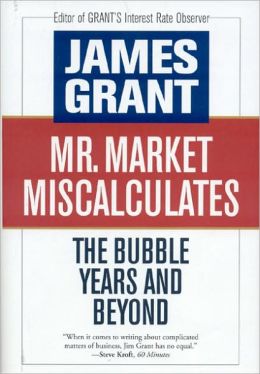One should begin a review with a summation of a book and then of its author. The reverse is warranted in this case. James Grant is an extraordinary American, a financial expert whose mind is enriched by his knowledge of history. His previous book was an excellent biography of John Adams. It did not receive the recognition it deserves. (But then, in these times and in this world, can one expect recognition from people who have little or no cognition themselves?) Yet this true amateur of history is recognized as the author and editor of a most valuable newsletter, Grant’s Interest Rate Observer, wherein his observations and obiter dicta rate considerable interest.
This volume consists of a series of articles from Grant’s, selected from those written during the last ten years. Many of them deal with the names of the endlessly complicated, and often semiliterate, definitions of abstract financial instruments that have bespattered and crowded and clogged the “economy” during the last 30 years at least. So why bother to review such a book for readers of Chronicles? Because through almost all of these articles appears James Grant’s reasoning, his knowledge of history, and his common sense, which should be of interest to any literate conservative. In one instance he describes
the difference between physics and economics. Both use quantitative methods to build productive models, but physics deals with matter; economics confronts human beings. And because matter doesn’t talk back or change its mind . . . if you believe that human action is unpredictable, you will not be overly impressed by econometric forecasts of next year’s GDP.
Grant believes that the final divorce of the U.S. dollar from the gold standard in 1971 was a definite turning point, eventually leading to disaster. Yes, but with two caveats. First, 1971 had been preceded by the restriction of the gold standard in 1944, indeed in 1934. And second, the United States could not have maintained the gold standard for her currency alone in the world; and a reestablishment of the gold standard would be well-nigh impossible now. What will happen with money—here, and indeed anywhere in the world—is more than an open question: unforeseen and incalculable. What we ought to recognize (and I wonder whether James Grant would agree) is that the Age of Money, part and parcel of an age of materialism, having reached its peak around 1900, is now gone. Like everything else—houses, stocks, bonds, books, even men and women—its worth is more or less what people think it is. Money has become an abstraction. Our money in the bank consists of figurations of graphic dust on films faraway, we know not where. People keep talking of the Information Age, but this is not in-formation but its very opposite: the imaging of matter.
Grant believes that the Age, and the practices, of Morgan and Vanderbilt and Frick and Carnegie were better than those of Milken and Rubin and Greenspan and Madoff; but that is, or should be, obvious. He wrote about that in his earlier book, Money of the Mind: Borrowing and Lending in America From the Civil War to Michael Milken. In the present book we may discern an important departure from the still extant, nostalgic, and wholly illusory convictions of so-called capitalist and monetary dogmatic “libertarians” and “free-market” theologians. The “market”—whatever it means—is not always right; as a matter of fact, it seldom is. Economics—or, more precisely, the value of anything—is not a mathematical proposition. I can only hope that James Grant agrees that both Marx and Milton Friedman were wrong: What matters in this world is not the accumulation of capital (or indeed of anything material) but the accumulation of opinions—what and how people think. And that is a very complicated process, as Tocqueville, almost alone, saw: In a democracy, people change their minds not rapidly but slowly, sometimes agonizingly so. This ought to explain—Grant suggests this, but perhaps not strongly enough—why the contemptible opportunist and semiliterate Alan Greenspan (yes, dear “conservatives,” installed by Ronald Reagan), in charge of the nation’s currency, was revered as The Maestro by public thinkers and speakers and commentators and by the Wall Street Journal for 20 years, even though he was and remains responsible for, among other things, the worshipful promotion of an “ownership society” where not even “real estate” remains real, since by now more than 50 percent of owners of houses “own” them not at all. James Grant deserves credit for pointing out Greenspan’s chortling imbecilities. My interest in “economics” is minimal, but, somehow, I found it necessary in 2000 to record in my diary a fundamentally stupid proclamation by Greenspan:
Before this revolution in information availability, most twentieth-century business decision-making had been hampered by wide uncertainty . . . indeed, these developments emphasize the essence of information technology—the expansion of knowledge and its obverse, the reduction of uncertainty.
The very opposite was, and remains, true. A few months later came the sudden collapse of the boom in technology stocks, and eight years later of the entire housing and stock “market.” But The Maestro kept being applauded at the head of his orchestra—until now, when he is succeeded by his concertmaster and satellite Bernanke.
Thus do reputations persist and ideas move and opinions change, crawling with excruciating slowness, and sometimes with the most dreadful of consequences, in our mass-democratic age.
[Mr. Market Miscalculates: The Bubble Years and Beyond, by James Grant (New York: Axios Press) 430 pp., $22.00]

Leave a Reply